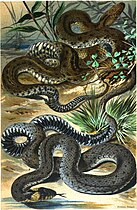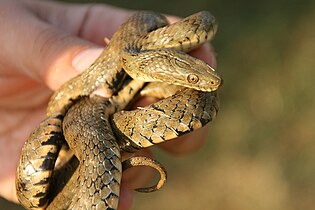Dice snake
| Dice snake | |
|---|---|

| |
| Eating a goby | |
| Scientific classification | |
| Domain: | Eukaryota |
| Kingdom: | Animalia |
| Phylum: | Chordata |
| Class: | Reptilia |
| Order: | Squamata |
| Suborder: | Serpentes |
| Family: | Colubridae |
| Genus: | Natrix |
| Species: | N. tessellata
|
| Binomial name | |
| Natrix tessellata (Laurenti, 1768)
| |

| |
| Distribution of Natrix tessellata | |
| Synonyms | |
|
Coronella tessellata Laurenti, 1768 | |
The dice snake (Natrix tessellata) or water snake[3] is a Eurasian nonvenomous snake in the family Colubridae, subfamily Natricinae. Its average length is 1.0–1.3 m (39–51 in). Body color may vary from greyish green to brownish or almost black, with dark spots on the back. The belly is sometimes vividly coloured in yellow or orange, with black spots, very similar to dice, hence the name.
Ecology
[edit]Living mainly near rivers, streams and lakes, it frequently feeds on fish. Sometimes, it feeds also on amphibians such as frogs, toads, and tadpoles.
While considered nonvenomous, N. tessellata produces a potent antihemorrhagin in its serum.[4] As a defence, it spreads a very bad-smelling secretion from its cloaca. Another defence mechanism is thanatosis, playing dead.[citation needed]
During the mating season (March–May), they congregate in large groups. Egg-laying is usually in July, and one clutch consists of 10–30 eggs. The young snakes hatch in early September. Dice snakes hibernate from October to April in dry holes near the water.[citation needed]
Distribution
[edit]The dice snake is found throughout much of central and eastern Eurasia, from Italy and Czechia in the west to Kyrgyzstan in the east, and from Ukraine in the north to Iran in the south.[1]
Conservation
[edit]The species is considered to be of Least Concern in its overall range, although local populations may be more sensitive.[1] For example, it is considered Critically Endangered in the Czech Republic, mostly due to destruction of habitats and the introduction of invasive American mink.[5]
Gallery
[edit]-
Illustration of dice snake (top) and grass snake (Natrix natrix) including underside
-
In Umbria, Italy
References
[edit]- ^ a b c Mebert, K.; Amr, Z.S.S.; Al Johany, A.M.H.; Aloufi, A.A.H.; Jiang, J.; Meyer, A.; Sterijovski, B.; Baha El Din, S.; Pleguezuelos, J.; Sá-Sousa, P.; Corti, C.; Ajtic, R.; Tuniyev, S.; Orlov, N.L.; Ananjeva, N.B.; Cogălniceanu, D.; Andrén, C.; Crnobrnja-Isailović, J.; Aghasyan, A.; Avci, A.; Tuniyev, B.; Lymberakis, P.; Wilkinson, J.; Üzüm, N.; Podloucky, R.; Kaya, U.; Vogrin, M.; Pérez Mellado, V.; Cheylan, M.; Nettmann, H.K.; De Haan, C.C.; Schmidt, B.; Lau, M.; Borkin, L.; Milto, K.; Golynsky, E.; Belouskova, A.; Rustamov, A; Nuridjanov, D.; Munkhbayar, K. (2021). "Natrix tessellata". IUCN Red List of Threatened Species. 2021: e.T157256A745071. doi:10.2305/IUCN.UK.2021-2.RLTS.T157256A745071.en. Retrieved 21 February 2022.
- ^ Boulenger, G.A. 1893. Catalogue of the Snakes in the British Museum (Natural History), Volume I. London. pp. 233-234
- ^ Guicking, Daniela; Joger, Ulrich; Wink, Michael (25 August 2009). "Cryptic diversity in a Eurasian water snake (Natrix tessellata, Serpentes: Colubridae): Evidence from mitochondrial sequence data and nuclear ISSR-PCR fingerprinting". Organisms Diversity & Evolution. 9 (3): 201–214. Bibcode:2009ODivE...9..201G. doi:10.1016/j.ode.2009.03.001.
- ^ Borkow, Gadi; Gutierrez, Jose Maria; Ovadia, Michael (December 1994). "A potent antihemorrhagin in the serum of the non-poisonous water snake Natrix tessellata: isolation, characterization and mechanism of neutralization". Biochimica et Biophysica Acta (BBA) - General Subjects. 1201 (3): 482–490. doi:10.1016/0304-4165(94)90080-9. PMID 7803481.
- ^ Chmelař, Jan; Civiš, Petr; Fischer, David; Frynta, Daniel; Jeřábková, Lenka; Rudolfová, Veronika; Rehák, Ivan (28 December 2023). "Protecting isolated reptile populations outside their main area of distribution: a predictive model of the Dice snake, Natrix tessellata, distribution in the Czech Republic". Biodiversity Data Journal. 11: e114790. doi:10.3897/BDJ.11.e114790. PMC 10767748. PMID 38188184.





